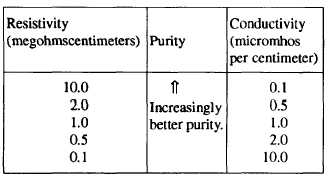shown in table 1-1. The purity meter indications will
vary with ionized salt concentration and the temperature
of the coolant flowing through the cell. The temperature
effect is canceled by a built-in temperature
compensation circuit.
The inlet conductivity is compared to a preset value
of cell conductance to actuate an alarm circuit when the
purity of the water drops below the preset level. In
addition, the purity meter provides direct readings of the
water purity at the inlet and outlet of the demineralize.
Typical operating requirements for the demineralize
are conductivity 1 micromno/cm at 77°F (resistivity 1
megohm/cm at 77°F), oxygen content 0.1 ppm by
weight, and mechanical filtration 0.5 microns absolute.
When water has been circulated through the system
for extended periods of time, a high resistivity or low
conductivity reading may be indicated on both input and
output samples. This condition is highly desirable and
indicates that all ionizable material has been properly
treated, and that the demineralize is maintaining a high
degree of purity. When a system is filled with a fresh
charge of water, it should be allowed to circulate for
approximately 2 hours before comparing the input and
output readings. During the initial circulation period,
the resistivity readings vary because of the mixing
action of water that has been treated by the
demineralize with the fresh charge of water. A properly
operating system can supply water of acceptable purity
in 4 to 8 hours. Water in a system that has been secured
for any length of time should be of acceptable purity
within 2 hours. The resistivity/conductivity reading
required for a specific installation must be maintained
for optimum operation of the cooling water system.
Your first indication of a problem in the
demineralize is usually indicated by abnormal purity
meter readings (too low or too high), an abnormal
flowmeter reading, and/or a light and audible warning
from the purity monitor. Some purity monitors
can be tested for accuracy by a built-in test function on
Table 1-1.—Distilled Water Resistivity Versus Conductivity
the meter to establish if the problem is in the purity
monitor. If the purity monitor does not have a test
feature, then use the calibration plug in place of one of
the conductivity cells to test the operation of the purity
meter. Most of the time, only routine maintenance is
required to return the demineralize to its normal
operating condition.
Maintenance of the demineralize consists
primarily of the scheduled replacement of cartridges
(before they are exhausted) and clogged filters.
Obtaining satisfactory service life from the cartridges
and filters is largely dependent on minimizing external
contamination. Replacement cartridges must be kept
sealed and stored in a cool dry place until used. The
circulating system must be kept tight to reduce the need
for makeup water. Makeup water, in arty case, should
be as particle-free as possible and should not exceed
0.065 ppm chloride.
OXYGEN ANALYZER
In some secondary cooling systems, an oxygen
analyzer is installed to measure the amount of dissolved
oxygen in the liquid coolant. The presence of oxygen
causes oxidation that leads to the formation of scale in
the cooling system. An oxygen analyzer has an oxygen
sensor installed in the supply side of the secondary
cooling system. The sensor is an electrolytic cell in an
electrolyte solution or gel. A thin membrane covers the
end of the sensor, which is inserted in the coolant. This
membrane is gas permeable to the dissolved oxygen in
the secondary coolant. This allows the oxygen to pass
through the membrane. The oxygen reacts with the
electrolyte, which causes a proportional change in the
amount of current flow in the sensor. The sensor’s
electrical output is measured and displayed on the
oxygen analyzer’s meter. ‘The meter is calibrated to read
the oxygen content in parts per million or billion.
Because of solid-state electronics and the few
components used, the oxygen analyzer requires very
little maintenance other than the cleaning and changing
of the electrolyte in the sensor. When the meter on the
analyzer requires frequent calibration because the meter
readings are drifting or changing sharply, you should
recognize that the analyzer has a bad sensor. When you
clean and recharge the sensor, use caution to prevent
contamination of the membrane from the oil on your
fingers.
Data
1-22

